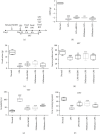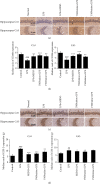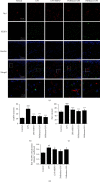Betaine Inhibits NLRP3 Inflammasome Hyperactivation and Regulates Microglial M1/M2 Phenotypic Differentiation, Thereby Attenuating Lipopolysaccharide-Induced Depression-Like Behavior
- PMID: 36339940
- PMCID: PMC9629937
- DOI: 10.1155/2022/9313436
Betaine Inhibits NLRP3 Inflammasome Hyperactivation and Regulates Microglial M1/M2 Phenotypic Differentiation, Thereby Attenuating Lipopolysaccharide-Induced Depression-Like Behavior
Abstract
Depression is one of the most important mental illnesses and is closely related to inflammation. Betaine is a natural product with an anti-inflammatory and antioxidant activities. However, the mechanism by which betaine ameliorates depression-like behaviors induced by lipopolysaccharide (LPS) is poorly understood. The purpose of this study was to investigate the neuroprotective effect of betaine on LPS-induced depression-like behavior in mice and its mechanism of action. ICR mice were randomly divided into four groups: the control group, the LPS model group (0.83 mg/kg), the positive drug group (MIDO, 50 mg/kg), and the betaine group (5% and 1% in drinking water). The betaine group was administered for 21 days, and on the 22nd day, except for the blank group, LPS (0.83 mg/kg) was intraperitoneally injected to establish a lipopolysaccharide-induced mice depression-like model. Twenty-four hours after LPS injection, the tail suspension test (TST), open field test (OFT), and sucrose preference test (SPT) were performed to evaluate the effect of betaine on LPS-induced depressive behavior in mice. After the behavioral study, the mouse brain, hippocampus, and serum were taken for detection. The expressions of cytokines and inflammatory mediators were detected by ELISA, HE staining, immunofluorescence, immunohistochemistry, and western blotting. Western blotting was used to detect the protein expression levels of the nucleotide-binding oligomerization domain-like receptor protein 3 (NLRP3), caspase-1, and ASC, the protein expression levels of the microglial polarization markers COX-2, inducible nitric oxide synthase (iNOS), and CD206. The results showed that betaine significantly ameliorated the depression-like behavior in LPS-induced mice, significantly attenuated the production of proinflammatory cytokines and increased the release of an anti-inflammatory cytokines. Betaine decreased the expression of the NLRP3 inflammasome, decreased the expression of M1 polarization markers, tumor necrosis factor-alpha (TNF-α), interleukin-1β (IL-1β), COX-2, and iNOS and promoted the expression of M2 polarization marker CD206. Our study suggests that betaine may promote the transition of microglia from the M1 to the M2 phenotype by inhibiting NLRP3 inflammasome activation, thereby attenuating lipopolysaccharide-induced depression-like behavior.
Copyright © 2022 Man Zhang et al.
Conflict of interest statement
The authors declare that they have no known competing financial interests or personal relationships that could have appeared to influence the work reported in this paper.
Figures








Similar articles
-
Targeting the NLRP3 Inflammasome-Related Pathways via Tianeptine Treatment-Suppressed Microglia Polarization to the M1 Phenotype in Lipopolysaccharide-Stimulated Cultures.Int J Mol Sci. 2018 Jul 5;19(7):1965. doi: 10.3390/ijms19071965. Int J Mol Sci. 2018. PMID: 29976873 Free PMC article.
-
NLRP3 inflammasome activation contributes to long-term behavioral alterations in mice injected with lipopolysaccharide.Neuroscience. 2017 Feb 20;343:77-84. doi: 10.1016/j.neuroscience.2016.11.037. Epub 2016 Dec 5. Neuroscience. 2017. PMID: 27923741 Free PMC article.
-
Involvement of the microglial NLRP3 inflammasome in the anti-inflammatory effect of the antidepressant clomipramine.J Affect Disord. 2019 Jul 1;254:15-25. doi: 10.1016/j.jad.2019.05.009. Epub 2019 May 5. J Affect Disord. 2019. PMID: 31082627
-
USP22 inhibits microglial M1 polarization by regulating the PU.1/NLRP3 inflammasome pathway.Brain Res Bull. 2025 Jan;220:111157. doi: 10.1016/j.brainresbull.2024.111157. Epub 2024 Dec 2. Brain Res Bull. 2025. PMID: 39631712
-
Betaine in Inflammation: Mechanistic Aspects and Applications.Front Immunol. 2018 May 24;9:1070. doi: 10.3389/fimmu.2018.01070. eCollection 2018. Front Immunol. 2018. PMID: 29881379 Free PMC article. Review.
Cited by
-
Microglial NLRP3 inflammasome-mediated neuroinflammation and therapeutic strategies in depression.Neural Regen Res. 2024 Sep 1;19(9):1890-1898. doi: 10.4103/1673-5374.390964. Epub 2023 Dec 15. Neural Regen Res. 2024. PMID: 38227513 Free PMC article.
-
Natural products for the treatment of depression: Insights into signal pathways influencing the hypothalamic-pituitary-adrenal axis.Medicine (Baltimore). 2023 Nov 3;102(44):e35862. doi: 10.1097/MD.0000000000035862. Medicine (Baltimore). 2023. PMID: 37932977 Free PMC article. Review.
-
Arginine Methylation of β-Catenin Induced by PRMT2 Aggravates LPS-Induced Cognitive Dysfunction and Depression-Like Behaviors by Promoting Ferroptosis.Mol Neurobiol. 2024 Oct;61(10):7796-7813. doi: 10.1007/s12035-024-04019-5. Epub 2024 Mar 2. Mol Neurobiol. 2024. PMID: 38430350
-
A comprehensive review of phytoconstituents in liver cancer prevention and treatment: targeting insights into molecular signaling pathways.Med Oncol. 2024 May 4;41(6):134. doi: 10.1007/s12032-024-02333-5. Med Oncol. 2024. PMID: 38703282
-
Making the case for prophylactic use of betaine to promote brain health in young (15-24 year old) athletes at risk for concussion.Front Neurosci. 2023 Sep 22;17:1214976. doi: 10.3389/fnins.2023.1214976. eCollection 2023. Front Neurosci. 2023. PMID: 37811321 Free PMC article. Review.
References
-
- Duan C. M., Zhang J. R., Wan T. F., Wang Y., Chen H. S., Liu L. SRT2104 attenuates chronic unpredictable mild stress-induced depressive-like behaviors and imbalance between microglial M1 and M2 phenotypes in the mice. Behavioural Brain Research . 2020;378:p. 112296. doi: 10.1016/j.bbr.2019.112296. - DOI - PubMed
Publication types
MeSH terms
Substances
LinkOut - more resources
Full Text Sources
Research Materials
Miscellaneous

